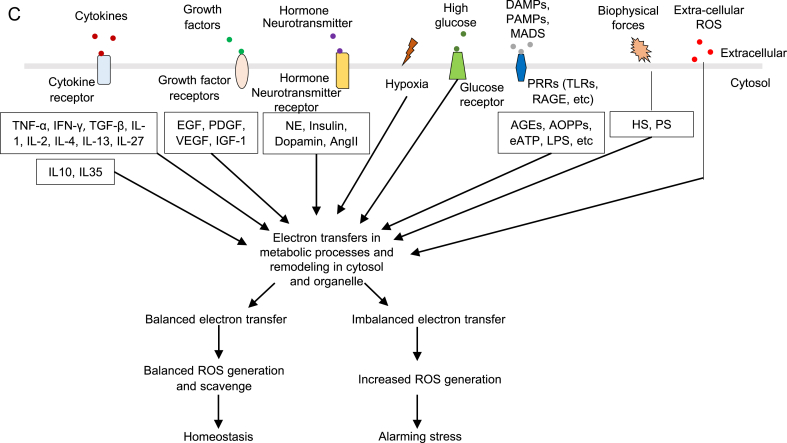Fig. 2.
A. Left panel (a): ROS induces ten types of cell functions (yellow) via various specific downstream pathways (grey). The ten cell functions include: 1) physiological signaling, 2) proliferation, 3) gene regulation, 4) cell cycle regulation, 5) epigenetic modification, 6) post-translational modification, 7) inflammation/innate immunity, 8) pyroptosis, 9) apoptosis, and 10) senescence. Right panel (b): The circus plot indicates that four major ROS generating and anti-ROS regulatory systems have both shared genes and unique genes. On the outside, each arc represents the identity of each gene list。On the inside, each arc represent a gene list, where each gene has a spot on the arc. Dark orange color represents the genes that appear in multiple lists and light orange color represents genes that are unique to that gene list. Purple lines link the same gene that are shared by multiple gene lists. Blue lines link the different genes where they fall into the same ontology them. (also see the detailed information in a supplemental table). Detailed information of Fig. 2A-b see supplemental Table 4.
Abbreviations: IRS1—insulin receptor substrate 1, DRP--dynamin-related protein, OPA1--optic atrophy 1, PTM—post-translational modification, H3K14Ac—histone 3 lysine 14 acetylation, PI3K--phosphatidylinositol-3-kinase, Akt--protein kinase B, mTOR--mammalian target of rapamycin, Ras—GTPase, MEK--MAPK kinase, ERK--extracellular signals-regulated kinase, NF-kB--nuclear factor kappa-lightchain- enhancer of activated B cells, MAPK-- mitogen-activated protein kinases, JNK-- MAPK-Jun N-terminal kinase, Nrf-- Nuclear factor erythroid2-related factor, CDK5--cyclin dependent kinase 5, CKD2-- cyclin dependent kinase 2, NLRP3-- NOD-, LRR- and pyrin domain containing protein 3, GSDMD—gasdermin D, SOD-- superoxide dismutase, LOX--lipoxygenase, NOX--NADPH oxidase. B. The ladder indicates different levels of ROS contribute to different cellular functions. In redox homeostasis state, ROS contributes to physiological signaling. Low ROS increase contributes to proliferation and angiogenesis. Moderated ROS increase contributes to inflammatory response and innate immunity. High ROS increase contributes to various types of cell death. C. Seven types of stimulations promote ROS production, including cytokines, growth factors, hormone/neurotransmitters, hypoxia, high glucose, DAMPs and extracellular ROS.
Abbreviations: TNF-α--tumor necrosis factor- α, IFN-γ-- interferon gamma, IL-1--interleukin 1, IL-2--interleukin 2, IL-4--interleukin 4, IL-13-- interleukin 13, IL-27--interleukin 27, IL-10--interleukin 10, IL-35--interleukin 35, EGF-- epidermal growth factor, PDGF--Platelet derived growth factor, VEGF-- vascular endothelial growth factor, IGF-1--Insulin-like growth factor 1, NE—Norepinephrine, AngII—angiotensin II, AGE-- AGEsadvanced glycation end products, AOPP-- advanced oxidation protein products, ATP-- adenosine triphosphate, LPS—lipopolysaccharide, HS-- Hemodynamic strain, PS-- Pulmonary stretch.



